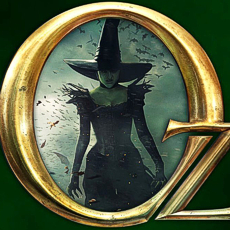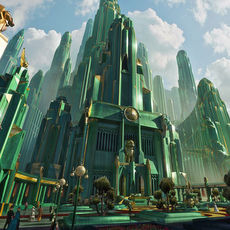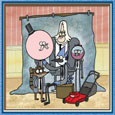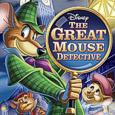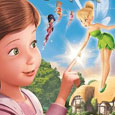Walt Disney Pictures (March 8 2013), Walt Disney Home Entertainment (June 11 2013), Blu-ray plus DVD Combo Pack and individual 3D Edition, 130 mins plus supplements (in combo pack only), 1080p high-definition original 1.33:1 and 2.40:1 variable aspect ratio, 7.1 DTS-HD Master Audio, Rated PG, Retail: $44.99 each
NOTE: Combo Pack and 3D Edition each sold separately
Storyboard:
This prequel to The Wizard Of Oz presents an origins story for how a small-time con-artist showman manages to become the great and powerful ruler of the magical land that Dorothy will eventually journey to.
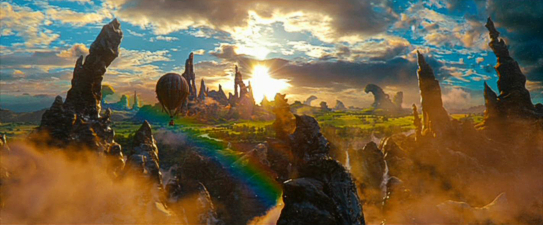
The Sweatbox Review:
“There’s no place like home”, decides the immortal Judy Garland as Dorothy in the 1939 classic MGM version of The Wizard Of Oz, based on the novel by L. Frank Baum, and ironically it was at home that I finally caught up with a “tentpole” movie that I had wanted to see in theaters earlier this year. Oz, The Great And Powerful was quite the big hit – one that has warranted a now in development sequel – not that you’d know it from how fast it seemed to appear and disappear from movie houses. Proving there was still an audience for charming, old-school family fantasies after Warner Bros’ big-budget Jack And The Beanstalk retelling Jack The Giant Slayer died a painful and public death at the box-office just a week earlier, Oz went in for the kill, making a mint in its first week despite middling reviews (mostly aimed at a supposedly lackluster performance from James Franco) and tailing off slightly when word went around that this was apparently no Wizard movie in the MGM sense.

And…then The Great And Powerful was gone. Barely a month after its opening, and having made a tidy half a billion-plus around the world, Oz seemed to disappear from theaters, its home video debut already being announced for just a couple of months later. As huge fan of both the original Oz books and the MGM musical, as well as an appreciator of several other related projects, I’d wanted to catch it on the big screen, and expected it to still be playing by the time I could make it around late April or May…by which time Star Trek Into Darkness and Iron Man Three had officially begun the 2013 summer movie season in style. Oz’s mid-March release – just a month later than the February slots that had made theatrical hits of several animated sequels that would have otherwise gone direct to video – seems to be a date policy that Disney wants to continue to explore, since its Tim Burton-helmed take on Alice In Wonderland proved so successful three years ago.
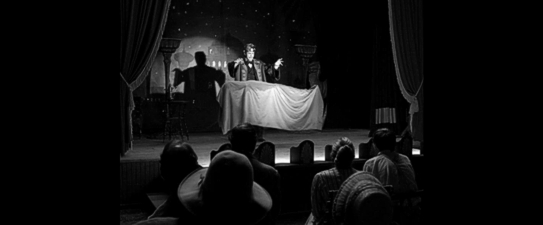
Oz, The Great And Powerful is very clearly a response to that success: despite a different director in Sam Raimi, Robert Stromberg’s production design and, naturally, Danny Elfman’s music too easily evoke a Burtonesque spirit; the opening title sequence, with its swirls and kooky sideshow imagery mix recalling the similar feel to Burton’s Alice, a film that with its billion dollar gross in the bank (and a Burton-less sequel on the way) this new film very much wants to be and, with its similarly dated release and marketing, doesn’t seem to be shameful in wanting to resemble so much that the audiences who made Alice such a hit subconsciously make the easy connection and come along for this ride into another wonderland too. Looking at times like a young Bruce Campbell (who, like the director’s touchstone that he is, turns up late in the film as a Winkie Guardsman in some really rubbery latex), Raimi has picked his Spider-Man trilogy co-star James Franco as the titular wizard to be.
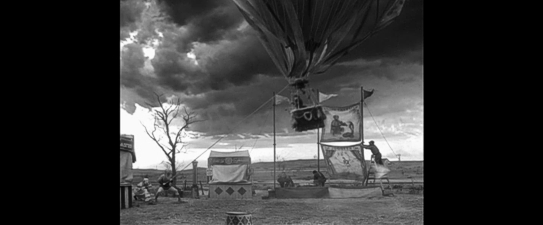
Perhaps a little young to be in the role (if he’s to become Frank Morgan in MGM’s classic it means he’ll have had to be stuck in Oz an awful long time), it comes as no surprise that Johnny Depp was an early contender (as was Robert Downey Jr before Raimi decided the chemistry wasn’t there) and he might have brought a little more world-weariness and aged experience to the character. Here introduced as a sideshow con-artist magician named Oscar, I wasn’t too fond of how he has already coined the performing name of Oz – this, as I understand it from the books, already existing as the land in which author Baum set his original stories before anyone ever journeyed there (in their imaginations or not). If Oz is in Oscar’s imagination (and, unlike Dorothy, the implication here leans towards it not being a dream) then this opens whole can of Inception-style worms regarding how others can go there and back!

The Disney Studios has, of course, been down this Yellow Brick Road before with Walter Murch’s Return To Oz and, just as what was old from the 1980s has become new again, it’s no surprise to find the studio wanting to try again. By turns taking its quirks from the MGM film’s playbook as well as harking back – intentionally or not – to Murch’s 1985 film, Oz, The Great And Powerful at least attempts to bring the feel of the Baum books to the screen. Published at the turn of the 20th Century, Baum’s The Wonderful Wizard Of Oz was the original Lord Of The Rings or Chronicles Of Narnia, launching an unprecedented American franchise at the time, spawning a stage musical just two years later (and the first adaptation to shorten the title to lose the “Wonderful”), several silent and early sound film translations before MGM stepped in (some under Baum’s own Oz Film Production Company), and further novels that brought the tally up to almost twenty, all set in a terrifically detailed land of various locations and habitants that were mapped out in the pages of each book around 50 years before Tolkien or Lewis took the same approach.
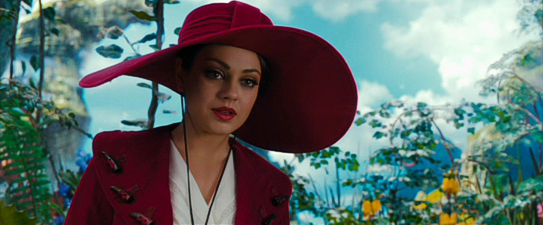
Walt Disney had sought to purchase the rights to the series in the 1930s, but it wasn’t until the success of Snow White And The Seven Dwarfs in 1937 that he could in any way afford to do so. However, MGM had already picked up the option and its film – ironically made as a response to Snow White’s smash status – has become indelibly linked to the property…so much so that each and every interpretation, from the disco-tinged The Wiz, The Muppets Wizard Of Oz and several television mini-series to the Broadway sensation Wicked all regularly reference (or do their best to avoid references!) the Garland film, depending on their copyright status. For instance, the famed Ruby Slippers were an MGM invention since the studio was eager to play up color in only their second three-strip feature; Baum’s originals were Sliver Slippers, not a terrific choice for Technicolor (I have also seen Emerald Slippers used as a perfect replacement that makes all kinds of sense whichever way you cut it).

The Oz copyrights have never failed to confuse me – owned by MGM though their classic 1939 musical, the film was not the hit that its reputation would suggest, only becoming a family favorite through perennial television re-runs in the 1950s. By this time the studio had let their rights lapse (The Wizard Of Oz had certainly not been the book-to-film franchise juggernaught that MGM’s deal with Edgar Rice Burroughs for Tarzan had been) and Walt himself finally acquired Baum’s initial eleven books as a result, attempting to turn The Mickey Mouse Club Mouseketeers into movie stars in the eventually aborted The Rainbow Road To Oz, a film that would become the soundstage-bound Babes In Toyland instead. Here things get murky: the Disney Studio retained certain rights for a good many years before Warners reasserted theirs after purchasing the classic MGM library (including The Wizard Of Oz, of course) and initially announcing a new Lord Of The Rings and Harry Potter style movie series before realizing that even their grip on the now public domain books was just as tenuous at best.

Even so, with Warners’ first dibs on the Baum stories open to question but their control of elements from the 1939 Oz under no doubt, Disney’s new film has had to be careful in not treading on anyone’s ruby slippered toes. This they do by cleverly circumventing Baum almost completely, going the prequel route (“The Wizard Begins”?) to create a whole backstory to Dorothy’s later adventures, as we discover who the Wizard actually was and where he came from. This was actually adequately set up in the MGM film quite well but we must not let a little thing like that get in the way of a burgeoning new franchise, and this trip to an earlier Oz also calls for some alternate Wicked-style origins for the original witches of Oz too. Despite all this, MGM’s Oz is still the yardstick to which all other versions are measured and, without being able to borrow from that film, Raimi still manages to reference it cleverly. His new film’s opening, for instance, is in black and white, even if I felt a sepia tone, like in the 1939 film, might have been more appropriate, especially for today’s audiences more accustomed to color and less accepting of grayscale monochrome…but perhaps this was deemed as being too close to MGM’s film.
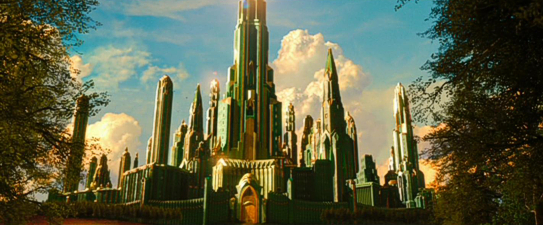
There’s also a nice 1930s feel to these scenes too: one couple asking Oscar to save their invalid child (spookily resembling a young Helena Bonham Carter in another Burton link) look right out of 30s Hollywood, and there’s the fun Peter Pan-ish angle repeated in having some of the real world actors playing Land Of Oz counterparts, such as Michelle Williams’ lovelorn potential beau for Oscar who, it is hinted, could be the future Dorothy’s mother. It’s all quite quaint and done with an innocent touch: for all his experience at CGI action in the Spidey films, Raimi stages Oscar’s early escape chase from a circus strongman (for reasons, I admit, I must have missed) with what must be an intentional lack of intensity, which works wonderfully given the old school feel. The film’s 2013 sensibilities come more to the fore as Oscar is whisked off to Oz by a twister – in traditional storm fashion – and Raimi gets to have fun with some slightly hokey visual effects, the biggest one being the gradual expanding and blooming of the black and white Academy aspect ratio frame to the fully saturated color of a modern day digital widescreen image.
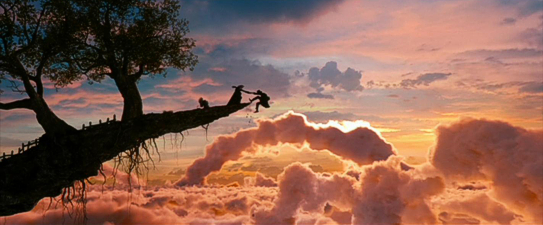
The effect, some 20 minutes in, is quite startling although not, I don’t think, as effective as the 1939 reveal that introduced color within the frame rather than just fading it in (perhaps it would have been more effective if Oscar had raised his head from inside the balloon basket and all of Oz’s glories were revealed through his eyes?). The color also seems to seep in a little too early in the shot and, once in Oz, I didn’t buy any of Oscar’s blue and green-screen balloon’s white water rafting (however appropriate a green screen may be given Oz’s primary color!). The land itself is a smorgasbord of influences: Burton’s Wonderland has been touched on already but I was also reminded of Song Of The South’s Zip-A-Dee-Doo-Dah sequence, Walt’s 1951 Wonderland and even, I felt, more than a hint of Fantasia in some of the more abstract sights. None of it looks like Franco is really there, and he’s not always adept at “seeing” the eyeline of some of the creatures, such as the river fairies, that would be added in later, but however “real” Oz looks, there remains a soundstage feel to the effects processing, perhaps intentionally leftover from the MGM movie.
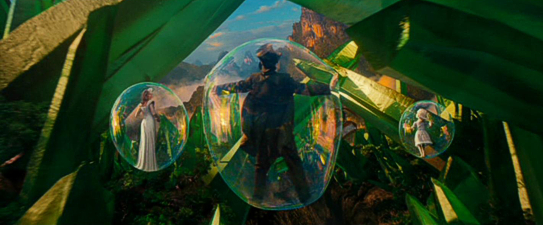
Certainly a lot of the designs and costumes have that period, almost Art Deco charm, especially the Emerald City, inspired by MGM and coming as close to it as legally possible while also recalling a certain fairytale castle, whereas elsewhere the sledgehammer values of modern moviemaking (swirling and dizzying camera moves, actually a Raimi trademark, and 3D-friendly tracking shots) rear their too noticeable and mostly non-fitting heads. At least the editing, perhaps as a result of the fast moving 3D work, is a little more leisurely than we’re used to nowadays, which gives us a chance to actually look at everything and take it all in. This includes the three witches of Oz themselves, allowing Mila Kunis, Rachel Weisz and Williams to ham it up in their respective roles. Kunis probably has the most amount to do, even if she does look like a female version of Jim Carrey’s The Mask later in the film, while Weisz is often on the brink of playing embarrassingly over the top, leaving it to Williams to try and make the most of her good witch Glinda.
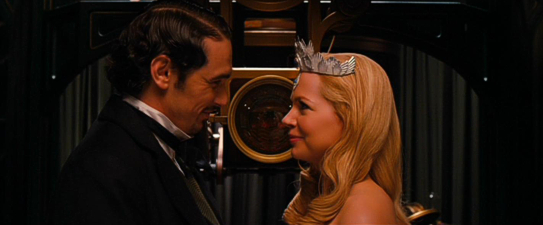
In a supporting role, Zach Braff has a little bit to do as an actor in the black and white opening though is mostly heard as Finley the winged monkey but, in perhaps the best example of Oz’s strange mix of photo real environments and hokey, obvious CGI elements, Finley never looks authentic in the way Gollum or Dobby did and whose wings even look like they were added in afterwards on top of the character animation. Not that Oz, The Great And Powerful is slow to get moving or isn’t enjoyable, but it’s not until 40 minutes in that the plot proper begins to unfold and, with Kunis and Weisz both potentially unpredictable, I was slightly disappointed that it would revert to the old “go defeat the old wicked witch” routine. I was also, for all the talk of the Wizard arriving to save of the “thousands of people” in Oz, perplexed as to where any of them were: for such an apparently well populated land, Oz is awful empty-feeling.
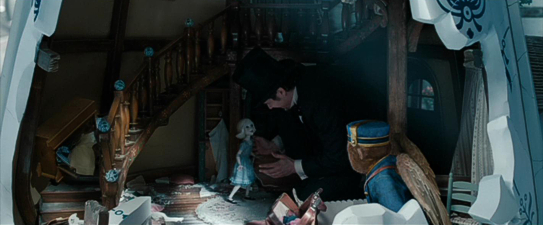
However, the witches’ task turns out to be something of a misdirection, allowing for alternative sub-plots to come into effect: more successful is a China Girl doll (from China Town, naturally), who integrates well and looks like a cross between Robin Wright and Cinderella – although it has to be said that Franco’s interaction with the character (performed during shooting via a marionette puppet) isn’t too convincing and none of the overlaid CG character elements, by Sony Imageworks – never a crew to stop rubbery animation get in the way of a good CG performance –are all totally successful. Likewise I found a sojourn in the Dark Forest to drag a little, while a plot resolve has Oscar and Finley all-too easily believing one of Glinda’s explanations right off the bat, and I also wondered, what with Glinda supposedly being the most beautiful witch, why her hair was as messed up as it was. I mean, who did her hair!? It should be immaculate but it’s all over the place, the individual strands showing up all the more in this pristine HD offering.

After the first hour the odyssey feel of Oz starts to wear a little thin and, even when we do finally meet some of the land’s citizens they remain a detached bunch who don’t really seem to be interested in engaging in the action. Indeed the whole film, as visually stimulating and enjoyable as it is, has a slight air of detachment about it, almost as if this was a film as fake as its supposed hero. As the witches show their true colours (quite literally, and sardonically with the aid of the kind of magic apple that might have killed Snow White but for love’s true kiss), Oz breathes back into life even if the storytelling becomes looser, things start to happen for the sake of them happening and characters begin to go through the motions because that is what is expected of them. Simply put, Oz’s final hour doesn’t build on the promise of its first – there are still some nice touches, but some clunkers, too: a song for the belatedly introduced Munchkins sounds like a rejected cue from Elfman’s Charlie And The Chocolate Factory score, the Wicked Witch’s CG animation transformation, like much of the CG in the film, is too rubbery and, at times, pretty badly done, surprisingly so for such a huge studio tentpole picture and franchise hopeful. I did think, “really? That’s it? That’s the best you can do to introduce one of the greatest movie villains of all time?”
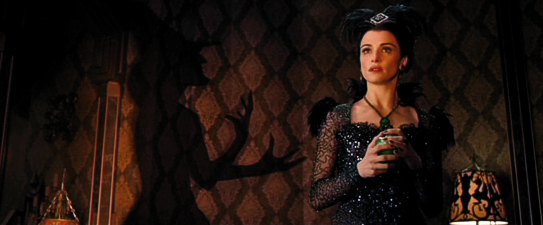
Another plot point, concerning the fate of the flying monkeys, demands you know your Oz lore from the 1939 film, but then I questioned why the China Girl was not affected in the same way, in yet another inconsistency. Elsewhere across the board, other elements are fine, especially Elfman, perhaps writing his best, most original and involving score in a long time and providing a big plus to the film, racking up another Disney assignment and seemingly resolving his personal feud with Raimi that apparently arose from the Spider-Man films, although even he can’t seem to save a “preparing for battle” montage that just seems to lack a bit of urgency or life. Largely this is down to Franco: despite a megawatt smile it is as if they shot the movie in reverse, as he’s much stronger in the earlier scenes and gets less confident in the role’s later moments. I wonder, too, if there was a last minute rush – some of the visual effects can look pretty rough: there’s a close-up of a coach’s wheels on a cobbled road and the two elements don’t look as if they are even touching each other.
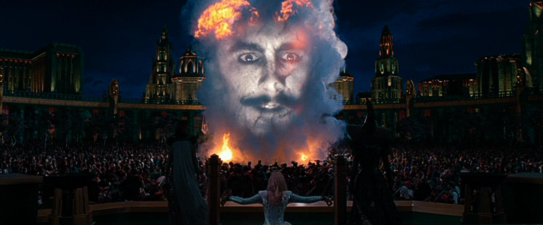
There’s a great Oz film out there somewhere but, The Great And Powerful doesn’t manage to be it, being too closely tied to Burton’s Alice in story and tone to succeed, as well as being hamstrung by having to stay away from getting too close to the likes of The Wizard Of Oz and Wicked while dealing with the same characters and themes. Personally, I’ve always felt Murch’s Return To Oz gets the closest to Baum’s books; it was a film beset with its own story and production problems but remains ahead of its time. Perhaps one of the many other Oz films coming down the pipeline might nail it better: certainly I’m looking forward to how Universal treats its translation of Wicked even if it is another musical. But there’s a whole bunch of terrific pre-LOTR and Narnia stories out there with just as much scope and surely ripe for authentic big screen adaptations. So far Warners have been fairly quiet on the subject, save for announcing a 3D makeover for the 1939 classic. This Oz makes for a pleasant diversion but it’s not always full of many wonderful things. We may be off to meet the Wizard for the first time, but Great And Powerful turns out to be a pretty subjective term.
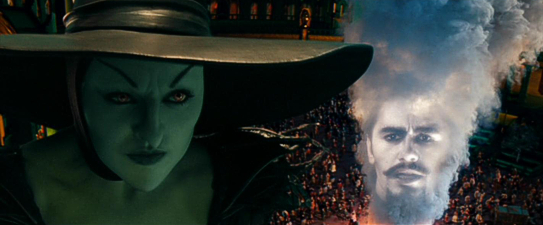
Is This Thing Loaded?
In a bizarre switcheroo of Disney’s usual Blu-ray release practices, Oz, The Great And Powerful comes to disc in not one regular combo pack…but as two (or more if you include the amount of different DVD and single disc BD editions). The main package includes the BD and DVD with a Digital Copy download code, while a separate 3D option includes just the 3D disc and Digital Copy download code at the same (expensive) price point. Perhaps Disney is realizing that home 3D isn’t taking off: certainly the Oz 3D package seems thrown together somewhat and is as bare bones as the disc inside…or maybe this is just an unfortunate money grab for those that will inevitably purchase both editions to get the full package? Don’t do that, by the way – check our packaging comments below first…

The regular combo pack includes the movie along with a selection of featurettes and clips that do the usual Disney job of revealing a bit of the magic but sadly omitting to go too in-depth, especially by way of including any kind of audio commentary. However, it’s a fair selection of supplements overall, barring the limitations of the first offering – despite a listing on the packaging and promising lots of goodies, the Oz, The Great And Powerful Second Screen experience will be a frustrating let down to most: not indicated on the packaging and only revealing itself when trying to access the feature from the disc itself is the fact that owners “need a second generation iPad or above for the magic to occur”!
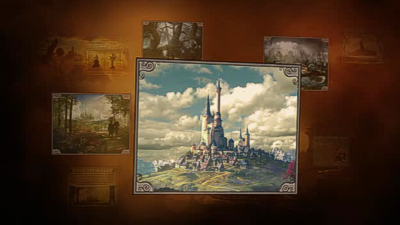
Now I’ve never personally liked the Second Screen concept much, but at least I’ve been able to explore some of these options through a computer in the past. Now that the accessing this content has become limited to a specific device, I feel more than ever that Second Screen material should be available right on the disc. As a sometime Mariah Carey fan, I was looking forward to seeing the video for what I felt was one of her best singles of recent times, the end-credit song Almost There, but this turns out not to be on the disc (as the early press announcement suggested) and only available through an iPad device I do not own. Thank goodness for YouTube is all I can say: if Disney doesn’t want to play nice and share then I can do without their attempts to get me to purchase another Apple product.

Breaking the chronological listing and actually heading back before this new Oz film was a glint in a franchise producer’s eye, fans will want to jump to the excellent featurette Walt Disney And The Road To Oz (10:20), which delves into Walt and his Studio’s past connections with the Oz books. Being a combination Disney and Oz fan, I have to say that I knew most of this already, hence my summary of those events in my review above, but this is a terrific collection of facts and concept art for Walt’s proposed The Rainbow Road To Oz Mousketeer feature as well as how that project did have its influences on later films, and it’s very cool to see, amongst the many alternate projects mentioned, that the Studio’s 1985 follow-up Return To Oz (looking great in HD) isn’t overlooked and given due respect.

Moving on, the rest of the supplements pretty much run the gamut of production, showing lots in their featurette-sized chunks: My Journey In Oz, By James Franco (21:40) is actually a very good, super-serious look at the film from his co-stars and crew, including director Raimi. The amount of on-set footage we get to see is a bonus, as well as some fairly candid soundbites from his castmates, all of whom speak intelligently about their contributions. Mostly cobbled together from hand-held camera recordings by Franco himself, there’s clearly a relaxed atmosphere between the participants, and they offer a huge amount insight in this brief twenty minutes than some audio commentaries do over a feature’s length.

China Girl And The Suspension Of Disbelief (5:25) has a clever title, intentional or not, because of the way the doll was brought to life as a marionette on set and later re-rendered in CG, and Before Your Very Eyes: From Kansas To Oz fills its eleven minutes by focusing on Alice In Wonderland and Oz, The Great And Powerful production designer Stromberg and the way he has created the Land Of Oz for this film. Among lots of concept art, it’s interesting to hear him speak about his influences: although no-one can mention the 1939 film its inspirations are clear, while there’s also an acknowledgement of the “Disney style” that I picked up on throughout the movie, as well as a confirmation of their intention to make the visuals feel like old-school soundstage settings.

A couple more featurettes continue to reveal the secrets behind the curtain: Mila’s Metamorphosis spends near eight minutes exploring the time it took to give the actress a wicked witch makeover, going from an initial four and a half hours to under two hours each morning to be ready to be evil on set. Mr Elfman’s Musical Concoctions profiles Raimi’s long-time composer collaborator and his score contributions to Oz, The Great And Powerful, returning to work with the director after their mysterious but much publicized feud that saw Elfman sit out Raimi’s third Spider-Man picture (probably for the best, as it turned out!). That public falling out understandably not only goes untouched upon here, but one would never know they ever had a spat, such are the compliments Elfman pays Raimi here.
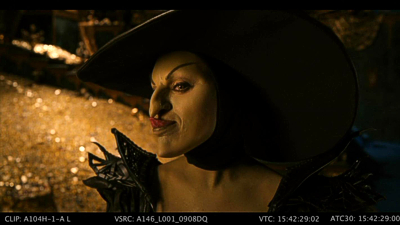
Focusing on the music – a film’s musical score is perhaps my personal point of interest in the overall finishing of a movie since, along with the editing, it can make or break a picture, and can certainly save a scene by bringing the right emotion along – the clip is naturally interesting, as Elfman elaborates on his approach to several key moments. Finally, a set of Bloopers, running just over a full five minutes, has the cast mostly goofing off or blowing their lines, all the while showing that they at least had fun while making the movie, and a couple of jokey pre-viz shots and, in particular, Kunis’ “party trick” keep things amusing enough. What’s clear from these extras is that is clearly a talented group of people making this movie, and they had fun doing so; it’s just a disappointment that the resulting film doesn’t always convey this sense of fun or is better than it turned out.
The combo pack also includes an enclosed DVD, which carries over the informative Walt Disney And The Road To Oz featurette and Bloopers as well as a Digital Copy, while the 3D package features nothing but the movie in that format and a Digital Copy download. Across all these discs, Disney’s selection of Sneak Peeks are actually fairly restricted, featuring a new (final?) trailer for its big summer hope, and extremely entertaining looking, The Lone Ranger, plus ABC’s Once Upon A Time: The Complete Second Season, The Little Mermaid’s Diamond Edition 3D debut, Iron Man Three and the Disney Infinity online game concept.
Case Study:
It’s the yellow-bordered BD, DVD and Digital Copy as well as the separate Blu-ray 3D editions under review here, and I have to say it feels as if Disney hasn’t got as much faith in this release that the film’s near $600m worldwide gross would usually encourage. For one thing, both the combo and 3D packs seems underwhelmingly designed: the combo pleasingly uses a version of one of the theatrical posters (an oddly composed one-sheet itself, with the witches seemingly Photoshopped into a shot of Franco on the Yellow Brick Road), and there’s the usual big-release substance of an embossed slipcover and sparkle emitting from the Emerald City, but the slimline BD case feels light and insubstantial.
Likewise, the 3D edition’s slipcover is flat and with only a faint hint of a glossiness than should really be dripping off a title like this (especially given that you’re essentially paying over $30 just for the box); the 3D edition doesn’t even get the kind of lenticular frontage that the Studio’s dimensional releases usually enjoy. Is this a sign of the future? Certainly it seems the Studio’s home video department has some new designers in: the “disc chart” found on the back of most Disney titles has been dropped (also on some of the Studio’s other June 11 2013 animated catalog issues) and the result is a flatter, less elaborate and plainer style. The combo pack is the way to go for the extras, but the 3D edition should be much more enticing when you figure all you get is the movie at the same cost.

Do not, however, pick both editions up! Inside each one is an offer to send off for the other pack’s extra disc: so, in the combo pack owners can send off for the additional 3D disc to complete their set, and in the 3D edition, there’s the offer to send for the regular Blu-ray Disc with the movie and its extras. Of course, there’s a cost: $5.99 for each title which, given the high price point of each issue to begin with (both are set at the cost for what a full-featured combo pack including 3D would normally sell around), again raises questions over how Disney are handling (or fumbling?) this release on home video. Is it an experiment to see how many 3D copies would be shifted if they weren’t included in those combo packs? Who knows, but it’s an odd way of releasing such a big and sure to be popular title.
Note also that there’s no mention of needing the newer iPads (only!) in order to access the Second Screen content. This shouldn’t really be a reason anyone is buying Oz The Great And Powerful but just be aware that the added material, including a handful of extra featurettes and that Mariah Carey video, are not on the disc itself and not optional through anything other than the second generation iPads. Inside, the inserts are limited to the offer for the extra discs, sweepstakes, and the titles’ Movie Rewards codes.
Ink And Paint:

For all its visual sights, and their faults, Oz, The Great And Powerful looks, well, great and powerful. This would really be a stellar demo image if the blue and green screen effects didn’t look so layered, an effect I felt was exemplified by the 3D edition. The regular Blu-ray Disc has a super-sharp picture, itself full of depth and giving off that faintly pleasing theatrical soundstage vibe, although I did notice some shimmering and/or aliasing crosstalk on some of the Emerald City backdrops, albeit only on a handful of shots. Otherwise this is demo material – particularly in the climax with the Wizard’s smoke and mirrors projection and when the witches go all Star Wars on each other – only let down by the images’ layering and compositing. Could it be it is too sharp for its own good?
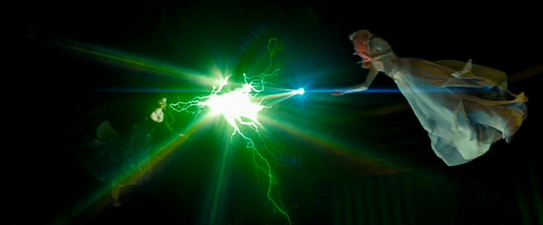
On the Blu-ray 3D disc sold separately, the fact that the film was shot in the format makes a world of difference in finding the format worthwhile or not. As opposed to Alice In Wonderland’s widely reported post-conversion disappointment, Oz’s native extra dimensions feel much more natural, although the added D can sometimes only reveal more of the live actors and CG character eyelines being out of register. The layered/soundstage effect is both more noticeable and less worrisome, this theatrical feel somehow seeming more suitable in 3D in creating a dreamlike, studio-set world, and Raimi’s nice wide angles mean the dimensional framing is quite enveloping.
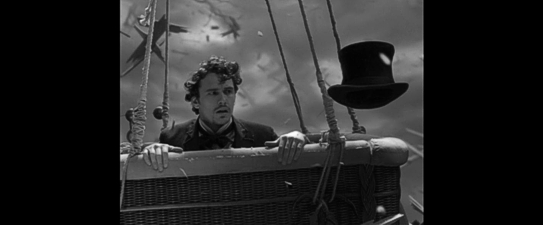
As well as the added depth, Oz is the rare modern day film that also has fun in having a creature scream into our faces, or in throwing the odd object out of the screen – there’s a very nice 3D moment early in the film when Oscar almost loses his hat from the balloon (an ongoing Indiana Jones-style lift that plays throughout). Other parts are more predictable: fireworks shooting right for us will play to 3D’s strengths like it or not, but ultimately the format doesn’t make the performances or sometimes quite staggeringly bad visual effects (for a big studio film like this) any better. It’s a take it or leave it option which Disney has made all the easier by making both editions available separately.
Scratch Tracks:
One can’t really go wrong in mixing a big, blockbuster studio movie the way some special effects can sometimes be anything less than special on the visual side, and Oz, The Great And Powerful certainly manages to engage us with its sound, here represented by a DTS Master Audio track. Elfman’s score is almost a constant in the film, and it is by turns at the forefront and disappointingly more buried in the sound at various points throughout the picture, but it always sounds good, supporting the film wherever and however it can.
Audibly, the crystal clear sound is as revealing as the HD image, only playing up how pedestrian some of the dialogue is, or how hammy some of the performances are when what they should have really done is go all out and give themselves completely over to full belief and faith in the project. In many ways, and despite the many aural and visual delights Oz, The Great And Powerful presents, it’s odd to report that the best moments come right at the start in the old-school black and white opening.
Final Cut:
Great And Powerful? Not so much, I’m afraid, although less demanding kids will probably enjoy its overblown opulence. I had hoped to catch the film theatrically in March and had been looking forward to it as an Oz fan, which probably explains my enjoyment at the film’s opening twenty minutes. The overall movie’s story is actually pretty robust and, for a non-Baum canon Land Of Oz plot could quite easily stand alongside the books as a convincing addition to the Wizard’s origins, launching the kind of series of serious-minded Oz films that I still hope will happen someday. However, the film suffers from some incredibly bad CGI for a big ticket Disney picture and a clutch of non-committed performances that can only be levelled at the actors having little to react to in a largely blue-screened world.
The film found an audience, to be sure, but it’ll be interesting to see how it does on home video and if a potential sequel is as successful. Disney’s separate combo and 3D packs may simply confuse matters for consumers who don’t realize what each set contains, and then having to shell out another few bucks to get either the 3D disc or the one with the extras on may well irritate – especially those that pick up both overpriced packs on release day without knowing they can apply for the alternate discs. Is this a new Disney policy? Are they testing the waters to see if 3D is worth supporting? It’s a strange title to try doing so with, if that’s the case: while enjoyable enough, Oz, The Great And Powerful’s shortcomings outweigh the good. Not a classic in the Wizard sense, this Oz is more lame and disappointing.
 | ||
 |


